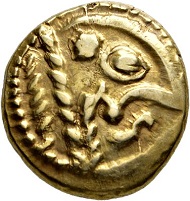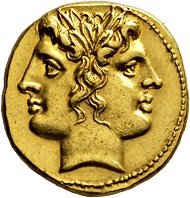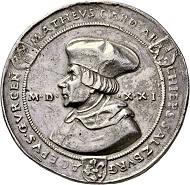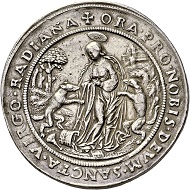06-12-2016 – 01-01-1970
Auction 163
Numismatic Rarities at Numismatik Lanz
Numismatic dealership Lanz will auction off 710 lots comprising coins and medals from all over the world in their own premises on 7 December 2016. The lionshare of the material on offer are ancient coins with a focus on electrum, the Roman Republic and Roman Imperial times. In the pre-1871 Germany department – or the Holy Roman Empire as it is called at Lanz – a collection Freising will be sold, completed by a large selection Salzburg. Of course, the foreign countries will be present with a number of rarities as well. So you better take a look at the catalog yourself to check for something that will add to your collecting area.
Lot 2: Celts. Bellovaci (Gaul). Gold stater, ca. 57 BC. Very rare. Extremely fine. Estimate: 2,000 euros. Starting price: 1,200 euros.
A small assortment of exquisite Celtic coins will kick off the auction sale. Among other items, it comprises a gold stater of the Bellovaci, dating from the middle of the 1st cent. BC, featuring a depiction on its obverse that would not have any problems passing for a modern work of art (Lot 2 / EF / 2,000 euros).
Lot 72: Knossos (Crete). Stater, 425-360. Extremely rare. Very fine. Estimate: 10,000 euros. Starting price: 6,000 euros.
About 140 Greek coins will be next, including rare items like a half stater from Byzantium (Lot 30 / FDC / 2,000 euros), an Archaic stater from Crete with the minotaur on the obverse and the maze on the reverse (Lot 72 / VF / 10,000 euros), a magnificent dinar of Shapur I exhibiting a superb portrait (Lot 146 / EF/FDC / 10,000 euros), or a Siculopunic tetradrachm of an extraordinarily fine style (Lot 148 / EF / 7,000 euros).
Lot 62: Philip VI Andriscus, 150-148 (Macedonia). Drachm, ca. 149-148. Extremely fine. Estimate: 15,000 euros. Starting price: 9,000 euros.
The collector interested in Hellenistic portraits will get the opportunity to acquire a drachm of Andriscus which was sold in the last Lanz Auction already but was never paid (Lot 62 / EF / 15,000 euros).
Lot 113: Phocaea (Ionia). Electrum hekte, 477-388. Extremely rare. Extremely fine. Estimate: 4,000 euros. Starting price: 2,400 euros.
The range of offers includes electrum coins from Cyzicus, Mytilene and Phocaea, completed by strikings from unknown Ionian mints. To mention only one example: an extremely rare hekte from Phocaea, featuring a deer on its obverse and a seal above, as a reference to the minting city (Lot 113 / EF / 4,000 euros).
Lot 155: Roman Republic. Anonymous. Gold stater, 220 BC. Extremely rare. Extremely fine. Estimate: 40,000 euros. Starting price: 24,000 euros.
As regards the Roman Republic, more than 120 coins will cross the auction block, among them many rarities and gold strikings. Most likely the rarest coin is an early gold stater with the depiction of an oath swearing ceremony (Lot 155 / EF / 40,000 euros). It is commonly interpreted as the mythical oath sown by Aeneas to King Latinus.
Lot 268: Roman Republic. Marc Antony with Cn. Domitius Ahenobarbus. Aureus, 40. Extremely rare. Almost extremely fine. Estimate: 40,000 euros. Starting price: 24,000 euros.
But the material on offer comprises even more gold coins. The anonymous 60 asses piece in gold (Lot 157 / FDC/almost FDC / 7,500 euros) is supplemented by an aureus of Cestius and Norbanus (Lot 253 / almost FDC / 15,000 euros) and an aureus of Ahenobarbus featuring the portrait of Marc Antony (Lot 268 / almost EF / 40,000 euros). It hardly needs mentioning that denarii in a perfect grade also form part of the offer.
Lot 298: Vitellius, 69. Sestertius. Rare. Extremely fine / almost extremely fine. Estimate: 10,000 euros. Starting price: 6,000 euros.
The auction comprises more than 200 coins dating from Roman Imperial times that are made of all materials, gold, silver, and bronze. Several of these have an impeccable provenance, as, for instance, this attractive sestertius of Vitellius that belonged to the Mazzini Collection (Lot 298 / EF/almost EF / 10,000 euros).
Lot 388: Elagabalus, 218-222. Aureus, 218/9. Extremely rare. FDC. Estimate: 15,000 euros. Starting price: 9,000 euros.
Numerous attractive gold coin will also come under the hammer, as an aureus of Elagabalus that depicts the emperor between two soldiers on the reverse (Lot 388 / FDC / 15,000 euros).
Lot 453: Magna Urbica, wife of Carinus 283-285. Aureus, 284. Very rare. FDC. Estimate: 40,000 euros. Starting price: 24,000 euros.
The highlight of the Roman coins is an aureus of Magna Urbica from the Imhoof-Blumer Collection that was offered for sale in an auction held by Jacob Hirsch in 1907 (Lot 453 / FDC / 40,000 euros).
Lot 460: Licinius I, 308-324. Aureus, 321/2, Nicomedia. Extremely rare. Extremely fine. Estimate: 40,000 euros. Starting price: 24,000 euros.
It leads on to a small batch of Late Roman gold rarities in the best grade possible, including an aureus of Diocletian from Antiochia (Lot 455 / FDC / 10,000 euros) and an aureus of Licinius I, with the full frontal portrait, from Nicomedia (Lot 460 / EF / 40,000 euros).
Lot 517: Constantine VII Porphyrogenetos, 913-959, with Romanos I and Christopher. Solidus, 921. Extremely rare. Extremely fine. Estimate: 10,000 euros. Starting price: 6,000 euros.
Among the Byzantine coins, many a rarity can be found, too, as a solidus of Constantine VII Porphyrogenetos that shows his stepfather and co-emperor Romanos I and Romanos’ eldest son Christopher on its reverse (Lot 517 / EF / 10,000 euros).
Lot 546: Freising. Johann Franz Egcker von Kapfing und Lichtenegg, 1695-1727. Gold medal by Christian Ernst Müller in the weight of 12 ducats 1724, Augsburg. Very rare. Almost FDC. Estimate: 20,000 euros. Starting price: 12,000 euros.
A small selection of coins and medals from Freising will open the second part of the auction consisting of coins and medals from all over the world. Chronologically, the spectrum ranges from the Middle Ages until the present. Two very rare ducats from of Clemens Wenceslaus of Saxony from 1765 and 1766 (Lot 549 and 550 / almost EF and EF / 8,000 euros each) as well as an extremely rare gold medal in 12 ducats weight, minted at the behest of Bishop Johann Franz Egcker von Kapfing und Lichtenegg, constitute the highlights of this selection (Lot 546 / almnost FDC / 20,000 euros).
Lot 558: Salzburg. Matthäus Lang von Wellenburg, 1519-1540. Double schautaler 1521. Rare. Almost extremely fine. Estimate: 8,000 euros. Starting price: 4,800 euros.
An assortment of almost 70 lots of Salzburg coins also form part of the auction sale. The chronological range reaches from Leonhard von Keutschach (1495-1519) to Archduke Ferdinand (1803-1806). Most strikings have estimated prices in the three- and four digit regions.
Lot 628: Bavaria. Albrecht VI of Leuchtenberg, 1584-1666. Gold gnadenpfennig no date (1618), by medallist Alessandro Abondio and Christoph Ulrich Eberl. Unique. Extremely fine. Estimate: 80,000 euros. Starting price: 48,000 euros.
A gold gnadenpfennig of Albrecht VI of Bavaria-Leuchtenberg (Lot 628 / EF / 80,000 euros) is the spectacular highlight. He was the brother of much more well-known Maximilian I who was to become one of the main protagonists of the Thirty Years’ War. Albrecht’s gnadenpfennig illustrates the purpose of many of these heavy gold coins made in Baroque times: They were reworked into a piece of jewelry and worn on the clothes as a token of princely favor. In the present case, the gold smith who had worked the floral ornament and the little angels’ heads is well-reputed. Thanks to archival records we know that it was Christoph Ulrich Eberl whom Maximilian I also commissioned with striking the gnadenpfennig specimens. On the occasion of being invested with the electoral dignity in 1623, Maximilian had him rework 60 gold coins into gnadenpfennigs.
Lot 662: German Empire. Bavaria. Ludwig III, 1913-1918. Pattern for 5 marks 1914. Proof. Estimate: 5,000 euros. Starting price: 3,000 euros.
This Lanz auction also entails a small batch of German Imperial coins with some rarities. To mention only two: a pattern for 5 marks Bavaria 1914 (Lot 662 / Proof / 5,000 euros) and a 20 marks Prussia 1915 A (Lot 664 / almost FDC/FDC / 4,000 euros).
Lot 668: China. Yuan Shihkai, 1915-1916. Gold medal (ca. 1930) after the dollar no date (1916), Tientsin. Rare. Almost FDC. Estimate: 15,000 euros. Starting price: 9,000 euros.
43 lots comprising coins from foreign countries conclude the auction sale. Containing much interesting material, browsing the auction catalog will certainly pay off.
Please remember! Only a customer attending the Numismatik Lanz Auction directly – sending a bid by letter or phone, over the internet or participating in person – is entitled to the preferential starting price of 60%! Please make sure to plan ahead: The auction sale catalog can be viewed online at Sixbid. You may as well request a printed copy for a nominal charge of 15 euros at Numismatik Lanz, Maximiliansplatz 10, D-80333 Munich, email, phone: +49 / 89 / 29 90 70, fax: +49 / 89 / 22 07 62



































